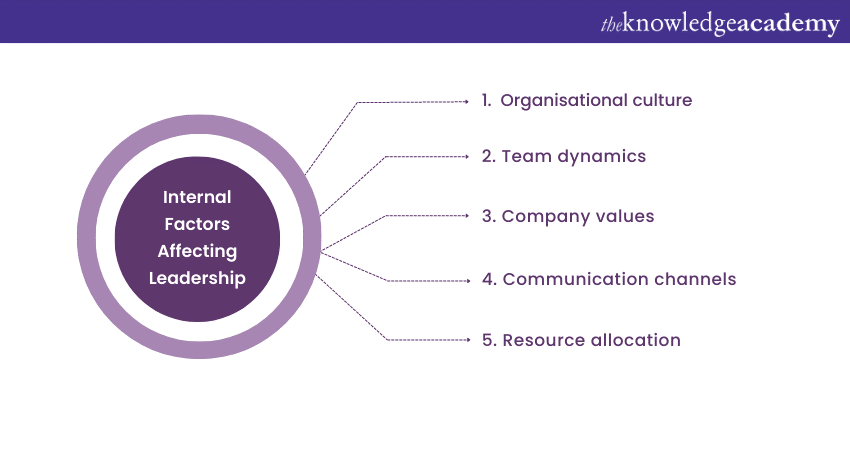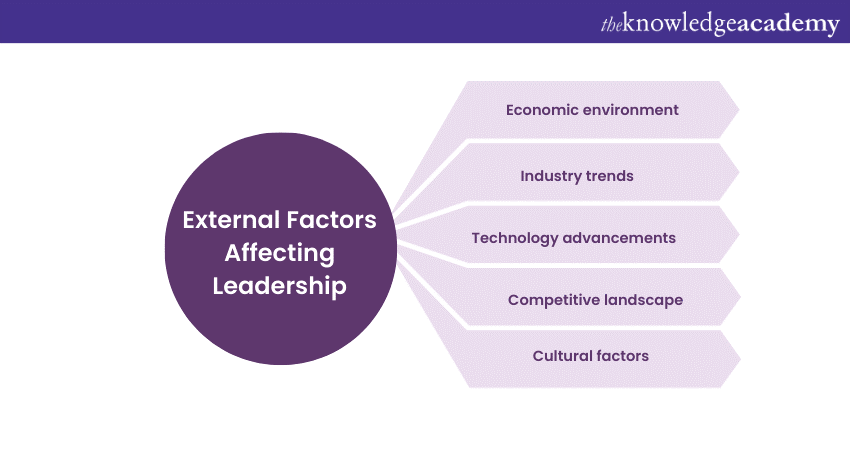We may not have the course you’re looking for. If you enquire or give us a call on +800 312616 and speak to our training experts, we may still be able to help with your training requirements.
Training Outcomes Within Your Budget!
We ensure quality, budget-alignment, and timely delivery by our expert instructors.

Leadership is a dynamic journey influenced by a myriad of internal and external factors. Understanding how leaders adapt to external changes while aligning internal strategies with external goals is essential for driving growth, fostering a positive work culture, and achieving long-term success. It must be kept in mind that not all Leadership styles are the same, as there are certain Factors Affecting Leadership styles.
According to Zippia, while 83% of organisations believe it is important to develop leaders at every level of the company only 5% of businesses have implemented Leadership development at all levels. However, there are certain factors that affect Leadership. In this blog, we will dive into the Factors Affecting Leadership as well as the interplay between these elements that shape Leadership styles.
Table of Contents
1) Factors Affecting Leadership
a) Internal factors
b) External factors
2) The interplay of external and internal factors
3) Conclusion
Factors Affecting Leadership
Before we dive into the Factors Affecting Leadership, we will first define what Leadership is. Leadership is the art of guiding and inspiring individuals or groups towards a common goal. It involves the ability to influence and motivate others, fostering collaboration and achieving collective success.
Effective Leadership empowers people to reach their full potential and drives positive change within organisations and communities. Now, we will expand on the different factors that affect Leadership.
Internal factors
Internal factors have a profound impact on the Types of Leadership Styles within organisations. These factors are closely tied to the company's internal workings and culture, shaping how leaders lead their teams

1) Organisational culture: Organisational culture plays a pivotal role in defining Leadership styles. A supportive and empowering culture fosters participatory Leadership, encouraging open communication and collaborative decision-making. In contrast, a hierarchical culture may lead to a more autocratic Leadership style, centralising decision-making authority with the leader.
2) Team dynamics: Team dynamics also influence Leadership approaches. A cohesive and aligned team might benefit from a democratic Leadership style, where collaboration and mutual respect drive decision-making. However, in teams facing conflicts, a more directive Leadership style might be necessary to restore harmony and provide clear direction.
3) Company values: Company values serve as a moral compass, guiding leaders' actions. Effective leaders align their styles with these core values, inspiring trust and ethical decision-making among their team members.
4) Communication channels: Communication channels significantly impact Leadership effectiveness. Leaders who maintain open lines of communication and encourage feedback often adopt a democratic style, fostering an inclusive work environment. Conversely, relying on top-down communication can lead to a more autocratic approach, reducing team engagement.
5) Resource allocation: Resource allocation decisions can also shape Leadership styles. Fair and transparent resource allocation reflects a democratic Leadership approach, enhancing team ownership and commitment. However, a more centralised allocation may indicate an autocratic Leadership style, prioritising swift decisions over team involvement.
Master the art of people management with our Successful People Management and Team Leadership Course that will elevate your Leadership skills!
External factors
External factors play a crucial role in shaping the Leadership style of individuals leading organisations or teams. These factors are beyond the direct control of the leader and are often influenced by the external environment in which the organisation operates. Let's dive deeper into the key external Factors Affecting Leadership style:

1) Economic environment: The prevailing economic conditions significantly impact Leadership styles. During times of economic prosperity, leaders may focus on growth, expansion, and innovation. They are more likely to take calculated risks and invest in new opportunities. On the other hand, in times of economic downturn, leaders may adopt a more cautious approach, emphasising cost-cutting, efficiency, and risk management.
2) Industry trends: Every industry experiences ongoing changes and trends that demand adaptability from leaders. Leaders need to stay abreast of the latest developments and innovations within their industry. Adapting to emerging trends and technologies is essential for maintaining a competitive edge and sustaining growth.
3) Technology advancements: Rapid advancements in technology have transformed the business landscape. Leaders need to be tech-savvy and willing to embrace new digital tools and solutions to enhance efficiency and productivity. Technologically competent leaders can better navigate the complexities of the digital age and drive digital transformation within their organisations.
) Competitive landscape: The level of competition in an industry also influences Leadership styles. In highly competitive markets, leaders may adopt a more aggressive approach, striving for market dominance and continuous improvement. In contrast, leaders in niche markets may emphasise relationship-building, customer service, and specialisation.
5) Cultural factors: Leaders operating in diverse cultural environments need to be sensitive to cultural nuances. Different cultures may value different Leadership attributes and communication styles. Effective leaders adapt their Leadership approach to align with the cultural norms and expectations of the workforce.
Enhance your Leadership skills with our Leadership and Management Skills Course. Sign up now to become a more effective and confident leader!
The interplay of external and internal factors
The relationship between external and internal factors significantly influences Leadership styles and organisational outcomes.
1) Adaptation to external changes: Leaders must adapt their strategies in response to external changes, such as economic conditions, industry trends, and technological advancements.
2) Alignment of internal strategies: Effective leaders align internal strategies with external goals to promote growth and success.
3) Impact of organisational culture: The internal culture of an organisation influences how it engages with external stakeholders and shapes its reputation.
4) Validation of internal strategies: Successful implementation of internal strategies gains external validation through increased market share and positive customer feedback.
5) Navigating external constraints and opportunities: Leaders navigate external constraints, such as government regulations, and leverage opportunities for innovation and growth.
6) Perception and reputation: External perceptions of an organisation's internal culture impact its reputation and brand loyalty.
7) Shared vision and alignment: Leaders create a shared vision to align employees and stakeholders towards common objectives.
8) Resilience and growth: Understanding the dynamic interplay empowers leaders to make informed decisions for sustainable growth and resilience amidst evolving business landscapes.

Conclusion
Effective Leadership is a delicate balance between adapting to external changes and aligning internal strategies with external goals. Understanding the interplay of external and internal Factors Affecting Leadership empowers leaders to make informed decisions, foster a positive organisational culture, and navigate challenges with resilience.
Unlock your Leadership potential with our comprehensive Leadership Training Courses. Join now for a transformative learning journey!
Frequently Asked Questions
Upcoming Business Skills Resources Batches & Dates
Date
 Successful People Management and Team Leadership
Successful People Management and Team Leadership
Thu 1st Jan 1970







 Top Rated Course
Top Rated Course


 If you wish to make any changes to your course, please
If you wish to make any changes to your course, please


